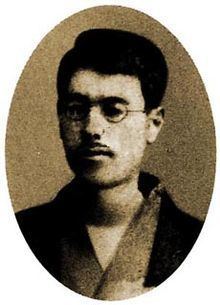Occupation Writer, philosopher Role Poet | Name Kitamura Tokoku Genre Poetry, essays Literary movement Romanticism | |
 | ||
Born 29 December 1868Odawara, Kanagawa Japan ( 1868-12-29 ) Died May 16, 1894, Tokyo, Japan | ||
Kitamura Tōkoku (北村 透谷, 29 December 1868 – 16 May 1894) was the pen name of Kitamura Montarō (北村門太郎), a Japanese poet, essayist, and one of the founders of the modern Japanese romantic literary movement in the late Meiji period of Japan.
Contents
Early life
From a samurai-class family of Ashigarashimo District, Kanagawa (part of present-day Odawara, Kanagawa Prefecture), Kitamura was interested in liberal politics at an early age, and played a minor role in the Freedom and People's Rights Movement. He attended the Tōkyō Senmon Gakkō (which later became Waseda University), but was expelled due to his radical political views. After almost a year of vigorous political activities, which occasionally involved robbery to raise funds, he started questioning the purpose of the movement and left to become a writer. He was also baptized as a Christian in 1888.
Literary career
Kitamura married Ishizaka Mina at the age of 19 in 1888, and in the same year he self-published the long verse Soshū no shi ("The Poem of the Prisoner"), which was the longest Japanese poem written in free verse up until that time. He followed this with the poetic drama Hōrai kyoku ("The Drama of Mount Hōrai"). He claimed to be influenced by the works of Byron, Emerson and Carlyle; his wife's Christianity also greatly influenced his outlook.
Kitamura turned from poetry to essays, and wrote works extolling the "life-espousing views" of the West, over the "life-denying view" of Buddhism and traditional Japanese Shinto thought. His attempts to explore the nature of the self and the potential for the individual, particularly in his seminal work Naibu seimei ron ("Theory of Inner Life"), are regarded by some as the starting point of modern Japanese literature. Kitamura was also drawn to the Quaker movement, and found a pacifist society, the Japan Peace Association (日本平和会) in 1889.
He was a close associate of Shimazaki Tōson, whom he strongly influenced towards the romantic literary movement.
Kitamura was hired as an English teacher at the Friends Girls School in 1890. He frequented the Azabu Christian Church. In 1893, he took over the post held by Shimazaki Tōson at Meiji Girls School (now Meiji Gakuin University). He also submitted literary criticism to the literary magazine Bungakukai, which he helped launch with Shimazaki Tōson in 1893. Around this time he began to show signs of mental instability and depression.
Before dawn on 16 May 1894, Tokoku hanged himself in his garden at his home near Shiba Park in Tokyo. His grave is at the temple of Zuisho-ji in Shirokane, Tokyo.
